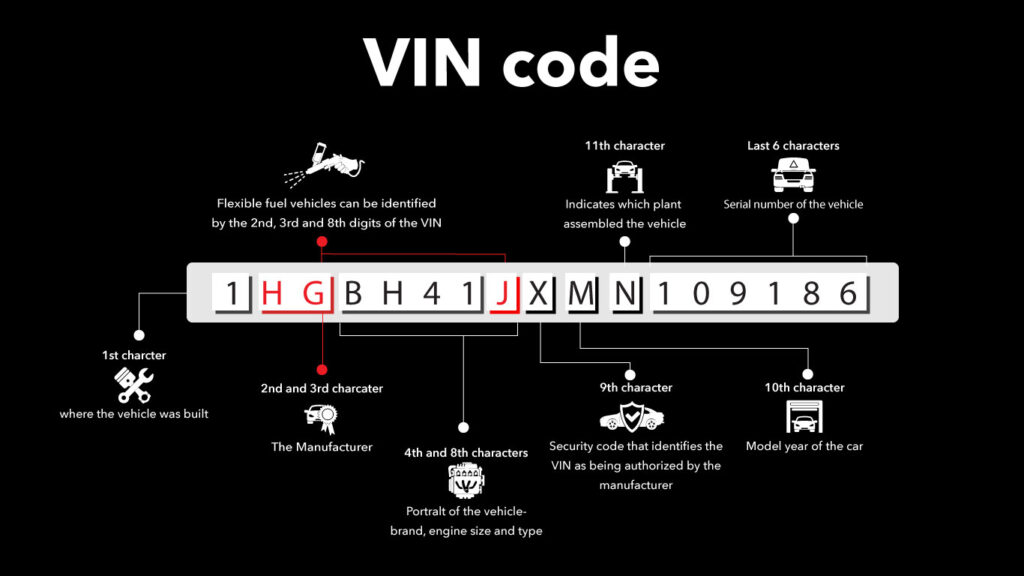Just like a fingerprint, your car’s VIN number can tell you all sorts of information, from where it was made and who by to its engine size, safety features, body style and production number. This makes it easy to find the right parts for your car, and check that everything’s legitimate before handing over cash on the forecourt.
In this guide, we offer practical tips on how to read your car’s VIN code and what each letter and number represents.
Use the links below to find the information you need.
Understanding a VIN Code
VIN codes are found on every car in the world built since 1983 and, even if cars were made on the same production line, no two VINs are ever the same. They’re made up of 17 numbers and letters which represent information about where the car was built and its exact specification, so you can find out pretty much all there is to know about a car from this unique code.
The diagram below shows examples of the kind of information you can get from your car’s VIN.
For a more in-depth look at reading your car’s VIN, read on.
How to Read and Decode Your Car’s VIN
If you spend a lot of time under the bonnet and enjoy DIY fixes, you should find out how to read your car’s VIN. This will make it easy to find the exact parts for your car, so you can keep your faithful old motor running well for longer.
Here, we look at what each digit in a VIN code means and how it can help you find out more about your car.
First 3 Digits – World Manufacturer Identifier (WMI)
The first three digits of the VIN are classified as the WMI, and show the country of origin, manufacturer, and specific division within a manufacturer.
1st – A letter or number showing where in the world the car was built
Remember the following:
- A-H – Africa
- J-R – Asia
- S-Z – Europe
- 1-5 – North America
- 6-7 – Australia and New Zealand
- 8-9 – South America
2nd – The manufacturer that made the car
A full list of manufacturers and their associated VIN codes can be found, here.
3rd – The specific division of a manufacturer that made the car
For example, Mercedes’ AMG division’s VIN is WMX.
Digits 4-8 – Vehicle Descriptor
The next five digits outline specific details about the car, including the engine size, safety features and body style.
4th – Safety features and model-specific information
The fourth digit gives details of the car’s model-specific features, such as additional safety information.
5th – The car’s series
This represents the exact series of a specific model, usually shown by a letter.
6th and 7th – The body style
Convertible, saloon or hatchback; the 6th and 7th digits show the car’s body style and type.
8th – Engine size
The eighth digit shows the car’s engine size and is usually represented by a letter. This is really helpful if you’re buying spare parts for your car, as is it ensures that you can find a spare that’s the exact match for the engine type.
9th Digit
This is called the ‘check digit’ and is used to validate the authenticity of the car’s VIN code. Using some complex maths that we won’t bore you with here, the check number should match up with the rest of the digits in the VIN. It’s difficult to check the validity of a VIN yourself as it requires some serious maths, but an online VIN de-coder should tell you if the VIN is legit.
10th Digit
The tenth digit shows the exact year the car was made, represented by a letter or number depending on its age. Using the table below, you can find a car’s year of manufacture through the VIN code – great if it has a personalised number plate or you want to check its validity before buying.
| 10th Digit | Year | 10th Digit | Year |
|---|---|---|---|
| A | 1980 | Y | 2000 |
| B | 1981 | 1 | 2001 |
| C | 1982 | 2 | 2002 |
| D | 1983 | 3 | 2003 |
| E | 1984 | 4 | 2004 |
| F | 1985 | 5 | 2005 |
| G | 1986 | 6 | 2006 |
| H | 1987 | 7 | 2007 |
| J | 1988 | 8 | 2008 |
| K | 1989 | 9 | 2009 |
| L | 1990 | A | 2010 |
| M | 1991 | B | 2011 |
| N | 1992 | C | 2012 |
| P | 1993 | D | 2013 |
| R | 1994 | E | 2014 |
| S | 1995 | F | 2015 |
| T | 1996 | G | 2016 |
| V | 1997 | H | 2017 |
| W | 1998 | J | 2018 |
| X | 1999 | K | 2019 |
11th Digit
The 11th digit shows at which manufacturer plant the car was made.
Digits 12 – 17
The last six digits of the VIN code is the production line number assigned by the manufacturer. This is the part of the VIN you’re least likely to need, however, in some cases, it can help to track down a part if certain changes were made to a specific model at the time of production.
Understanding how to decode your car’s VIN is not only satisfying, it can help you get the parts you need to keep it running at its best. It’s also a great way to learn more about a used car before you decide to buy, including its history.
Of course, there are easier ways to decode a VIN than going through the letters and numbers yourself. There are now several VIN-decoding services online that let you find information about your car in a matter of seconds, which is great if you need to find parts or check its history on the fly.
At Holts, our DIY car maintenance tools are great for quick fixes that will get you back on the road after a flat tyre or non-starter. For more information or to browse our complete product range, visit the homepage today.


